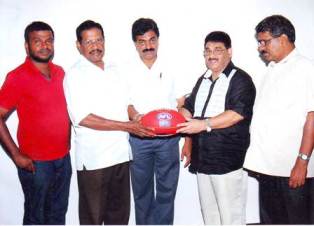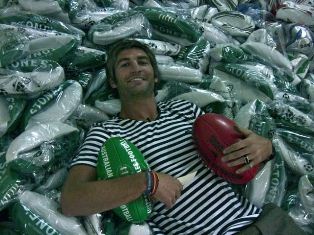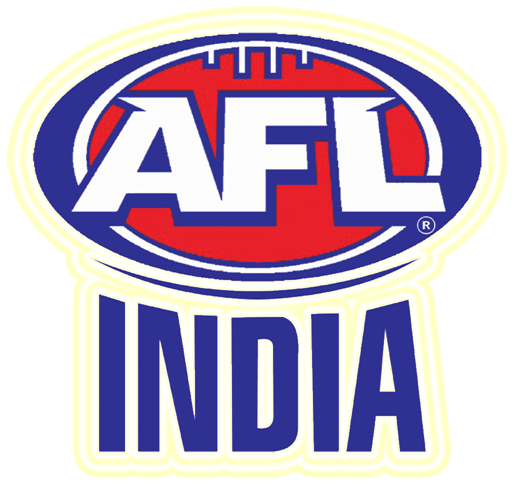Courtesy: thesundayindian.com
Published: 1st November, 2011.
 The game arrived in India in 2008 when Aussie cricket captain Ricky Ponting promoted it during his stint with the Kolkata Knight Riders. Since then, a team from India (there is no national team yet) has participated in two World Cups in Sydney. A governing body has also been set up with the team’s 21-year-old captain, Sudip Chakraborty, as the president.
The game arrived in India in 2008 when Aussie cricket captain Ricky Ponting promoted it during his stint with the Kolkata Knight Riders. Since then, a team from India (there is no national team yet) has participated in two World Cups in Sydney. A governing body has also been set up with the team’s 21-year-old captain, Sudip Chakraborty, as the president.
Sport theorists link Australian football, also called footy, to Gaelic soccer. It was basically a modification of rugby that was brought to Australia by the early Irish and European settlers. Others are of the opinion that the game was developed by Australian cricketers to stay fit. In fact, many Australian cricketers like Shane Warne play the game in the off season.
The first recorded Australian Rules football match took place in 1858 and the first set of rules was codified a year later. The rules of the game resemble those of rugby, American Rules football and soccer.
 Chakraborty explains that the Australian football is split into four quarters and is played on an oval field one-and-a-half times the size of a soccer ground. There are 18 players on the field per team. Each team tries to score through two sets of four poles on either end of the field. The ball is moved along by kicking or punching it. Throwing is not allowed.
Chakraborty explains that the Australian football is split into four quarters and is played on an oval field one-and-a-half times the size of a soccer ground. There are 18 players on the field per team. Each team tries to score through two sets of four poles on either end of the field. The ball is moved along by kicking or punching it. Throwing is not allowed.
A player is allowed to carry the ball only for a distance of 10 metres after which it has to be put on the ground or bounced. “This is tricky because given the shape of the ball, bouncing it and then catching it again is not the easiest of things,” says Chakraborty.
The game starts with the referee throwing the ball up in the air. The tallest members of the two teams, known as ruckmen, try to grab the ball off the air, quite in the manner of basketball players. If the ball goes out of play, it is thrown back in by the linesmen, who do so without looking at the field. Tackling is allowed like in rugby, but is limited to frontal challenges between the shoulders and knees provided the player has the ball or is within a five-meter radius of the ball. Fouls are penalised with free kicks or distance penalties.
When the game started in India three years back, its potential was obvious. So, when the first team was formed, several organisations like West Bengal Kabaddi Association (WBKA) and YMCA supported it. They provided the grounds and initial infrastructure. However, when India team returned from its first campaign in the World Cup without a win, these bodies lost interest.
Says WBKA’s Pranab Bhattacharya: “I am from the world of football and was, therefore, very enthusiastic initially. However, once India returned from the World Cup, we realised the game would be difficult to promote here. Where would we get fields that are nearly twice the size of football grounds?”
Some Scepticism, says Bhattacharya, also stemmed from the fact that Indians would be at a distinct disadvantage in a sport that calls for great strength and stamina. “We cannot compete with the sturdy foreigners. You cannot play without 18 strong and fit boys on each team. So we chose to distance ourselves from the game,” he says.
The players, however, beg to differ and are going all out to promote the sport. AFL-India has not yet been ratified by the government. “We need a presence in five different states for that to happen. So far, we have boards in West Bengal and Kerala. Work has been done in Gujarat, Maharashtra and Tamil Nadu and we hope to set up boards in there soon,” says Chakraborty.
 The Kerala board has already been ratified by the Kerala Olympic Association, thanks to the efforts of Rajiv Tharani, sports co-ordinator of the Olympic Association of Kerala. He says: “Kerala was the first state to register an Australian Football organisation in India in 2009. PA Hamsa is the president. We are planning to rope in people from neighbouring states, including footballers from Goa, and float a South Indian platform soon.”
The Kerala board has already been ratified by the Kerala Olympic Association, thanks to the efforts of Rajiv Tharani, sports co-ordinator of the Olympic Association of Kerala. He says: “Kerala was the first state to register an Australian Football organisation in India in 2009. PA Hamsa is the president. We are planning to rope in people from neighbouring states, including footballers from Goa, and float a South Indian platform soon.”
Australian football has an instantly populist feel to it. Like football, cricket and hockey, the lay public can play it almost anywhere and with any equipment. However, unlike hockey or football, this game is still evolving globally and so there is far less competition.
“We have lost out in the other contact sports because there was already a very strong international structure in place. So we could not compete. This game, on the other hand, is in the nascent stages in most parts of the world. Thus, if we are able to form our strategy and make a place for ourselves now, it will be much easier for us to make a mark,” explains the India team captain.
“The physical disparities will always remain but it can be surmounted with other skills. For example, the Japanese team has players of average height. However, they beat others through superior speed. The Indian team is very strong when the ball is on the ground. We are weak in long passes but on the ground, we are better than most teams. This can be utilised to our advantage,” he feels.
Infrastructure has quickly evolved in India. For one, the balls that are used internationally are made mostly in Jalandhar. “Earlier, we would ship in the balls that were exported from Jalandhar to Australia. Now we get them directly from Jalandhar with the AFI logo printed on them.” says Tharani.
Moreover, India has no dearth of cricket grounds which could be used for footy. They are of the required size and shape. In fact, most cricket fields in Australia are used for this sport in the off season.
Australia has of course been hugely enthusiastic about promoting the sport in India. The first Indian team that went Down Under was supported in a big way by AFL with funds, playing kit and jerseys, training facilities and official dinners.
 Brett Kirk, a legendary retired Australian player of the game and now the international ambassador for the sport, came to India to hold several clinics in Kolkata, Mumbai and Punjab. In fact, it is he who discovered the ball manufacturing units in Jalandhar.
Brett Kirk, a legendary retired Australian player of the game and now the international ambassador for the sport, came to India to hold several clinics in Kolkata, Mumbai and Punjab. In fact, it is he who discovered the ball manufacturing units in Jalandhar.
That apart, a massive campaign is about to be launched at the school level by the Australian company AussiX, which runs a training programme in Canada, where they have initiated more than 70,000 school students in the game.
An AussiX official says: “In India, we will focus on sports that interest the local community (not just Aussie Rules), and our model is to partner with sports service providers (NGOs).” AussiX’s first partner is the Abhinav Bindra Foundation.
“Bharatiya Vidya Bhavan School has 117 outlets throughout India. Ryan International School has a similar number. We have approached them. They will help us popularise the sport. Once that set-up comes through. AussiX will be running the programme in these schools,” reveals Chakraborty.
There are Indian supporters as well. Mega Cabs, Kolkata is providing a complete complementary cab service in the city for promoting Australian Football League – India. “MLA Sudip Bose helped us with the CA block ground for practice. We have also introduced the West Bengal sports minister Madan Mitra to the sport. Another big support is Railways minister Dinesh Trivedi,” Chakraborty says.
As the Aussies would say, it’s all happening out there!
















.jpg)

